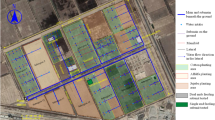Abstract
A study was conducted at the department of Agricultural Structure and Irrigation, Harran University, Sanliurfa, Turkey, to determine the effect of increased irrigation water temperature at various irrigation system pressures on emitter flow rate, lateral elongation, and Standard Flow Rate Index for six different brands of drip laterals. Test materials consisted of seven pressure and seven non-pressure compensating irrigation laterals from different manufacturers. Tests results showed that (a) tensile resistance stress tests indicated that 25% elongation levels were reached at about 40 kg of load. On average, pressure compensating laterals reached 25% elongation at 38 kg, while non-pressure compensating laterals reached 25% elongation at 32-kg load. There was no clear indication of the tested brands’ lateral wall thickness on the measurement, (b) pressure-regulated drip emitters had no or limited flow rate change due to increased irrigation water temperature, whereas non-pressure compensating emitters had significantly (P < 0.05) increased flow rates, and (c) finally, increased irrigation water temperature resulted in decreased flow rate variations that had a positive effect on standard deviation. Standard uniformity values improved with decreased flow rate variations in drip emitter flow rates.










Similar content being viewed by others
References
Abu-Gharbieh W (1997) Pre-and post-plant soil solarization. Plant protection and production. FAO paper no. 147, Roma
Al-Amound AI (1995) Significance of energy losses due to emitter connections in trickle irrigation lines. J Agric Eng Res 60:1–5
ASABE (2003) ASABE standards engineering practices data. 43rd edn. MI. USA p 864
ASTM (1999) Annual book of ASTM Standards, vol 08.08. p 29–31
ASTM (2000) Annual book of ASTM Standards, vol 10.02. p 39–42
Bhatnagar PR, Srivastava RC (2003) Gravity-fed drip irrigation system for hilly terraces of the northwest Himalayas. Irrig Sci 21:151–157
Bucks DA, Erie LJ, French OF, Nakayama FS, Pew WD (1981) Subsurface trickle irrigation management with multiple cropping. Trans of the ASABE 24:1482–1489
Camoglu G, Yavuz MY (2006) Boruya icten gecik (in line) ve distangecik (on line) damlaticilarda yapim farklikigi katsayisinin sulama yenesakligina etkisi. Akdeniz Universitesi Ziraat Fakultesi Dergisi 19(1):1–8
Clark GA, Lamm FL, Rogers DH (2005) Sensitivity of thin-walled drip tape emitter discharge to water temperature. Appl Eng Agric 21(5):855–863
Concepcion NC, Nelson ST, Mayob AL, Tingey DG, Smith MA (2003) Mixed groundwater system at Midway. UT: discriminating superimposed local and regional discharge. J Hydrol 273:119–138
Decroix M, Malaval A (1985) Laboratory evaluation of trickle irrigation equipment for field. Proceedings of the third International Drip/Trickle Irrigation Congress, California, USA. 1: 325–338
Dhuyvetter KC, Lamm FR, Rogers DH (1994) Subsurface drip irrigation for field corn. Cooperation and Ext. Service. Manhattan. Kansas. Rapid Prototyp J 9(2):104–110
Keller J, Bliesner RD (1990) Sprinkle and trickle irrigation. Van Nostrand Reinhold, New York
Kirnak H, Dogan E, Demir S, Yalcin S (2004) Determination of hydraulic performance of trickle irrigation emitters used in irrigation systems in Harran plain. Turk J Agric For 28:223–230
Lamm FR, Stone LR Manges HL (1992) Optimum lateral spacing for drip-irrigated corn. Written presentation at the 1992 international winter meeting of ASABE. ASABE paper No. 922575. St. Joseph. MI
Mizyed N, Kruse EG (1989) Emitter discharge evaluation of subsurface trickle irrigation. Trans ASABE 32:1223–1228
Mohamed MB (2003) Geothermal resource development in agriculture in Kebili region. Southern Tunisia. Geothermics 32:501–511
Ozekici B, Bozkurt S (1996) Boru ici (in line) damlaticilarin hirolik performanslarinin belirlenmesi. Turk J Agric For 23(1):19–24
Ozekici B, Sneed RE (1995) Manufacturing variation for various trickle irrigation on-line emitter. Appl Eng Agric 11(2):235–240
Parchomchuk P (1976) Temperature effects on emitter discharge rates. Trans ASABE 19(4):690–692
Phene CJ, Yue R, Wo I-Pai, Ayars JE, Schoneman RA, Meso B (1992) Distribution uniformity of subsurface drip irrigation systems. Written for presentation at the 1992 international winter meeting of ASABE. ASABE Paper no: 922569. St. Joseph. MI
Sinobas L, Juana L, Losada A (1999) Effects of temperature changes on emitter discharge. J Irrig Drain Eng 125(2):64–73
Stanley CD, Green RE, Khan MA, Santo LT (1990) Nitrogen-fertilization rate and soil nitrate distribution for micro irrigated sugarcane. Soil Sci Soc Am J 54:217–222
Von Bernuth RD, Solomon KH (1986) Emitter construction. Ch. 2.2. In Trickle irrigation for crop production. Elsevier, Amsterdam
Wei Z, Tang Y, Zhao W, Lu B (2003) Rapid development technique for drip irrigation. Rapid Prototyp J 9:104–110
Wu IP (1997) An assessment of hydraulic design of micro-irrigation systems. Agric Water Mang 32:275–284
Zerai H (1996) Groundwater and geothermal resources of Eritrea with the emphasis on their chemical quality. J Afr Earth Sci 22(4):415–421
Zur B, Tal S (1981) Emitter discharges sensitivity to pressure and temperature. J Irrig Drain Div ASCE 107:1–9
Acknowledgments
This study was supported by The Scientific and Technological Research Council of Turkey (TUBİTAK) with project number 106O264. The support was gratefully appreciated.
Author information
Authors and Affiliations
Corresponding author
Additional information
Communicated by A. Kassam.
Rights and permissions
About this article
Cite this article
Dogan, E., Kirnak, H. Water temperature and system pressure effect on drip lateral properties. Irrig Sci 28, 407–419 (2010). https://doi.org/10.1007/s00271-009-0202-z
Received:
Accepted:
Published:
Issue Date:
DOI: https://doi.org/10.1007/s00271-009-0202-z




